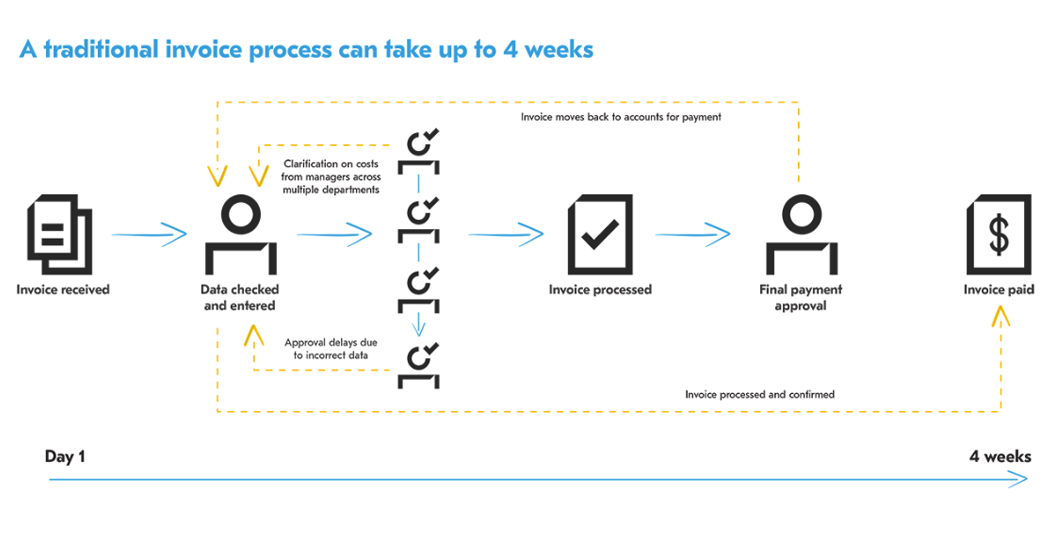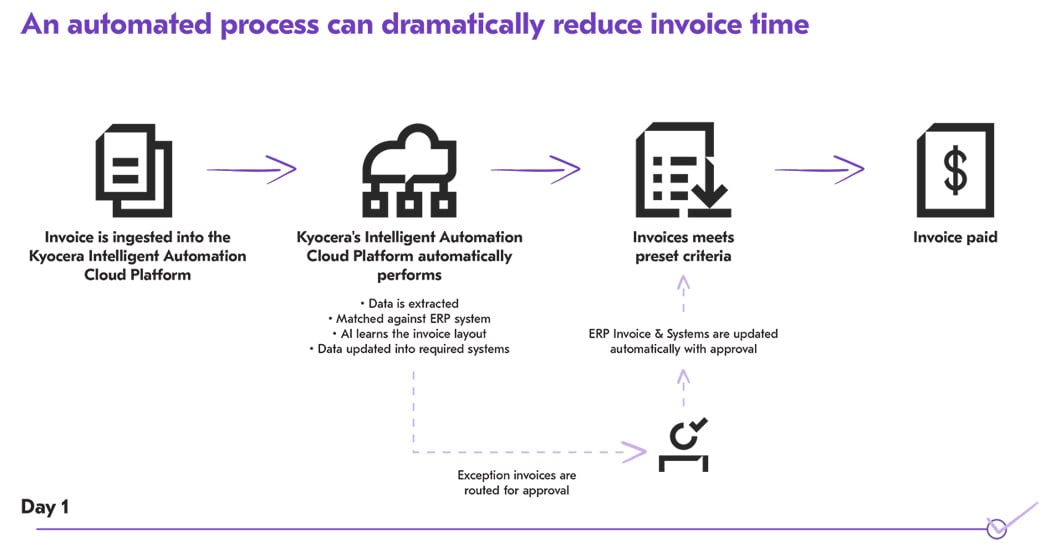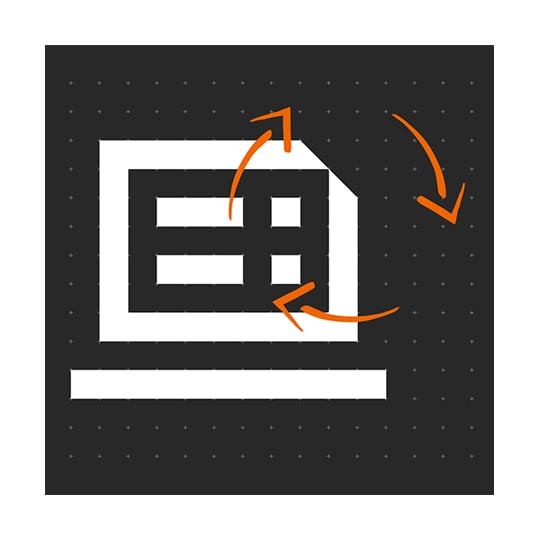Platform automation: Achieve efficiency on another level
Transform your organisation and thrive with the flexibility of a Business Process Automation platform

Modern demands see many organisations going digital and embracing automation or risk getting left behind. Smart organisations are turning to Business Process Automation technology to facilitate streamlining processes across various job roles, departments or organisations as a whole. From automating sales orders, HR on-boarding and off-boarding to warehouse automation, organisations have been able to find a competitive advantage and build efficiencies with Business Process Automation.
But not all robotic automation solutions are fit for purpose.
At Kyocera, we know every organisation is unique with vastly different automation requirements and that is why we developed the Kyocera Intelligent Automation Platform solution. Rather than making your organisation fit a rigid framework that could restrict your workflow, our solution provides organisations of all sizes with a cloud-based platform tailored to your RPA automation objectives.
What is RPA?
Robotic process automation (RPA), also known as software robotics, is a way of automating business processes using technology based on artificial intelligence (AI). These robots can navigate systems and undertake a variety of specific actions, including identifying and extracting data.
By learning how users conduct tasks, they can replicate these actions over and over. Because they’re programmed to follow certain rules, RPA removes the chance of human error and also takes care of repetitive tasks too mundane for people. This frees up time and resources for more creative endeavours, such as problem-solving and growing your business.
How can RPA empower your business?
Along with providing the confidence and comfort of knowing vital tasks are being done correctly, RPA boosts employee morale and productivity. RPA software works seamlessly in the background, allowing your employees to focus on tasks that require a human touch, like innovative thinking and collaboration. This means your business can continue to grow with its existing workforce.
Why use a cloud-based Intelligent Automation Platform?
Intelligent Business Process Automation provides organisations of all sizes with the ability to replace repetitive and expensive manual human tasks with intelligent robotic software. These digital robots give you greater insight into the process of a task and ensure it’ll be completed faster, without interruption and with total accuracy. Saving time and allowing employees to focus on business-critical activities.
By using a cloud-based automation platform like the Kyocera Intelligent Automation Platform, organisations gain the ability to easily tailor an automated process to a specific task or function. This gives you greater flexibility and enables your organisation or department to adapt as business requirements change.
Cloud-based automation platforms can also be used across multiple departments, cities or even countries within an organisation. It provides you with the freedom to carry out processes anytime, anywhere. So, no more relying on expensive in-house servers to run the automation.
What process or workflow can be automated?
One of the key benefits of our platform-based robotic automation is that any process can be handled without human input. Business intelligence and Robotic technologies like the Kyocera Intelligent Automation Platform can be tailored to your criteria, so the automated process conforms to the way you do business, instead of you conforming to the rules of the technology.
This gives you the freedom to choose which processes you want to automate. It could be automating a whole department where low cost, high volume tasks are taking over. Or minimising labour-intensive tasks, ensuring data accuracy and increasing security. RPA can even be tailored for high-cost individuals whose time and focus is being reduced by low-level tasks. An intelligent cloud-based automation platform ensures flexibility and direct resources to areas of value.
The process of creating these tailored solutions is quicker than you might think. We start with a detailed scoping period to ensure all criteria can be met and the solution is well planned. Then the delivery of your intelligent automated process can be as little as 4-6 weeks. It means much faster, more efficient, and more affordable than training new employees – that’s the beauty of a dynamic cloud-based platform.
How automation can build efficiencies
Increasing the efficiency of your business is one way to reduce expenses and improve your bottom line. Greater efficiency comes from taking less time to complete and process tasks or introducing a means to be able to do more within the same timeframe.
Avoiding repetitive human interaction using robotic process automation systems gives organisations the power to reduce workplace stress. It also increases data accuracy and enables information to flow between different systems. This more efficient and instant flow of information results in a seamless end-to-end process that can be tracked, measured, and viewed by internal stakeholders.
Traditional invoice process workflow
Traditional invoice workflows often involve several human touches across all levels of seniority. These tasks require data entry, invoice processing, approvals across multiple levels, and final payments. A complex and labour intensive process that sees organisations struggling with data errors, various back and forth communication, plus delays when people are not in the office. With no controls in place to monitor and flag outlying invoices, there’s also a risk of fraudulent invoices being submitted for payment. As a result, many businesses are stuck on a payment cycle that takes weeks to complete.

Automated invoice process workflow
With an automated accounts payable process, invoices enter into a workflow with key information gathered and populated into required fields without error or delays. The details are then processed, and all invoices that meet predetermined criteria are pushed on for payment. Outlying invoices that do not match the criteria are delivered to an employee for review – this only occurs based on business rules and actions that might require additional attention. The level of human interaction is significantly decreased, leading to superior data accuracy and much shorter processing times.

Unlock your full potential with automation
Automation can move data in and out of systems seamlessly without the need for human intervention. With solutions like the Kyocera Intelligent Automation Platform, utilising world-leading AI Machine learning technology to identify, extract, process, and post information into any system or location. This powerful platform engine can build business efficiencies no matter how complex the process is, without the need for software licensing or expensive server infrastructure.
The Kyocera Intelligent Automation platform is a fully managed ecosystem providing business-critical support, ensuring peace of mind.
Transform your organisation with a robotic automation platform and thrive
Some common use cases for automation include:
 Accounts Payable
Accounts Payable
Intelligent Invoice Capture and Approvals, Expense Claims, Intelligent Statement Reconciliation
Accounts Receivable
Multi-Channel Invoice Delivery & Reporting
 Purchasing
Purchasing
Intelligent Purchase Order Creation and Approval Workflows, Intelligent Supplier Contract Management & Communications
Human Resources
Employee Onboarding, Time Sheets, Employee Records Digitisation
Customer Order Processing
Intelligent Customer Order Processing, Customer Portals, Mobile Ordering, Warranty Claims Management, Customer Communications & Intelligent Reporting
Operations
Intelligent Forms, Content Management, Intranet Development, Analytics & Reporting, Document Digitisation
Warehouse
Intelligent Proof of Delivery, Goods Receipts & Paper Elimination

Kyocera Intelligent Automation Platform
Enhance People and Business Processes
FAQ
-
What is a digital transformation strategy?
A digital transformation strategy is a comprehensive plan that outlines how an organisation will leverage digital technologies to fundamentally change business operations, customer experiences and value delivery. This strategy addresses technology adoption including cloud computing and automation, process redesign to eliminate inefficiencies, data management and analytics capabilities, customer engagement across digital channels, workforce enablement through digital tools, cultural change management, and phased implementation roadmaps. Successful digital transformation requires executive sponsorship, employee engagement, appropriate technology investment and continuous adaptation to evolving capabilities. Business transformation turns challenges into opportunities through cloud storage, collaboration tools and automation. Digital transformation initiatives help organisations stay competitive and sustainable. Business solutions help organisations move into the digital age with intelligent information management.
-
What is invoice processing automation?
Invoice processing automation streamlines the complete invoice lifecycle from receipt through payment by automatically capturing invoice data, validating information against purchase orders, routing through approval workflows, flagging exceptions, and triggering payment execution. These systems use OCR and AI to read invoices in any format, extract key data fields including vendor details and line items, perform three-way matching with POs and receipts, apply business rules for routing and approvals, integrate with accounting systems, and maintain complete audit trails. Invoice automation reduces processing time by 60-75%, cuts costs from $27-30 to under $10 per invoice, and accelerates payment cycles. Automated invoicing makes tedious data entry obsolete through intelligent recognition. Process automation enables rapid invoice processing with AI-powered data extraction. Financial services solutions automate invoice capture, validation and approval workflows.
-
What is an accounts payable workflow?
An accounts payable workflow is the structured sequence of steps and approvals required to process vendor invoices from receipt through payment, ensuring proper authorisation, compliance and financial controls. This workflow typically includes invoice receipt and data capture, PO matching and validation, exception handling for discrepancies, routing to appropriate approvers based on amount and department, final approval and payment authorisation, posting to the general ledger, and payment execution. Automated AP workflows enforce consistent policies, prevent duplicate payments, provide real-time status visibility and maintain complete audit trails for compliance. Automated invoicing workflows instantly migrate tasks between employees, expediting the review process. Process automation routes documents automatically through predefined approval chains. How to improve AP processes includes implementing automated workflows and centralising data.
-
What is purchase order automation?
Purchase order automation streamlines the requisition-to-PO process through digital workflows that automatically create, route, approve and distribute purchase orders based on predefined business rules. These systems enable employees to submit purchase requests through self-service portals, automatically route requests through appropriate approval hierarchies based on amount and category, validate against budgets and preferred vendor lists, generate purchase orders automatically upon final approval, transmit POs electronically to vendors, and integrate with accounts payable systems for three-way matching. PO automation reduces processing time, prevents maverick spending, improves vendor relationships through faster PO delivery and provides spend visibility. Process automation services automate procurement workflows from requisition through payment. Business automation streamlines important business processes to create greater productivity. Automated document management handles procurement and contract management efficiently.
-
What is business process efficiency?
Business process efficiency measures how effectively an organisation converts inputs into outputs, minimising waste, time and resources while maximising quality and productivity. Efficient processes eliminate unnecessary steps, reduce cycle times, minimise errors and rework, optimise resource utilisation, and deliver consistent results. Organisations improve process efficiency through automation, standardisation, continuous improvement methodologies, technology enablement, employee training, and performance measurement. High process efficiency reduces operational costs, improves customer satisfaction, increases competitiveness and enables scalability. Process automation services eliminate manual intervention to work faster and smarter. Business process automation increases productivity while reducing costs. How MPS evolves towards MDS improves entire document workflows for greater efficiency.
-
What is supplier contract management?
Supplier contract management is the systematic process of creating, negotiating, executing, monitoring and renewing contracts with vendors to ensure compliance, optimise performance and mitigate risks. This includes centralised contract repositories with searchable archives, automated workflows for contract creation and approval, electronic signature capabilities, obligation tracking and milestone monitoring, renewal alerts to prevent auto-renewals, performance metrics and vendor scorecards, contract compliance monitoring, and spend analysis against negotiated terms. Effective contract management reduces maverick spending, ensures better pricing through consistent terms, improves vendor relationships and minimises legal and financial risks. Enterprise content management enables contract management with automated workflows and audit trails. Process automation handles contract processing with customisable workflows. Document management prevents missed contract renewal dates through automated alerts.
Talk to us, we're human
Our support team are here to help you with any queries about Kyocera products and services.
